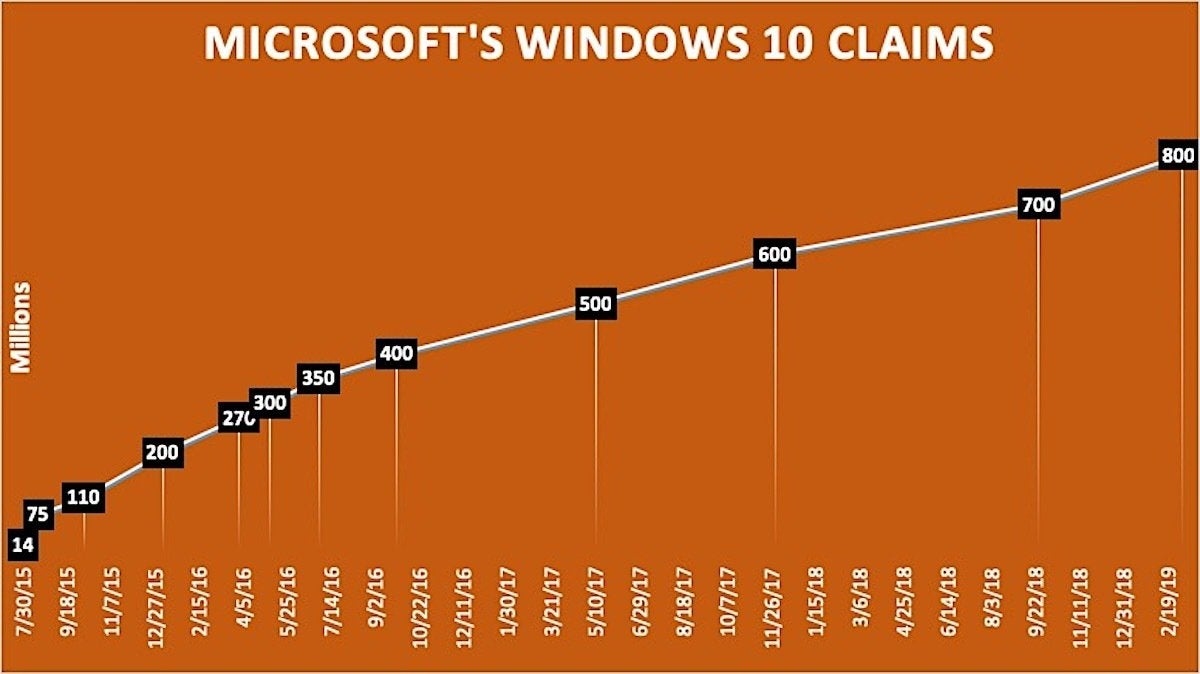If those numbers are accurate, the company is 80% of the way toward its goal of Windows 10 on 1 billion PCs and devices. But Windows 7 remains popular, too.
Microsoft on Thursday said that 800 million devices are now running Windows 10, a 100 million increase in less than six months.
"Thank you to all our customers and partners for helping us
achieve 800 million #Windows10 devices and the highest customer satisfaction in the history of Windows," Yusif Mehdi, a Microsoft vice president, tweeted.
The milestone put Windows 10 at the 80% mark toward a goal the company once pledged but subsequently discarded. In 2015, Microsoft said it was aiming for a billion Windows 10 devices within two or three years, meaning July 2017 or July 2018. But just a year after Windows 10 launch, the company conceded that the objective was unreachable.
Microsoft blamed that retreat on the failure of its once-ambitious smartphone strategy, which never met sales expectations and ultimately cost the company billions before it wound down a mobile hardware business.
Estimates based on third-party data put Windows 10 on substantially fewer PCs. According to Computerworld's latest calculation, based on analytics vendor Net Applications' measurement of Windows 10's user share and Microsoft's oft-cited contention that 1.5 billion machines run Windows, at the end of February, Windows 10's share of all Windows stood at 46.1%, which represented approximately 691 million systems. (February's Windows 10 user share was down from January's, almost certainly an artifact and not a true decline; in January, Windows 10 share of all Windows was 47.4%, or approximately 711 million machines.)
Net Applications' measurements include only personal computers; Microsoft's count also covers Xbox consoles, tablets and what few Windows-powered smartphones remain running.
Not surprisingly, Mehdi did not reveal data for the venerable Windows 7, the OS that Windows 10 is supplanting. By the same formula used to figure Windows 10's in-use number, Windows 7, which accounted for 43.9% of all Windows last month, ran about 659 million PCs.
Although Windows 7's support retirement is just 312 days away, the OS stubbornly clings to a position of power, a place it seems to have little desire to relinquish. Using the 12-month average change in user share, Computerworld recently forecast that nearly 41% of all Windows PCs will be running Windows 7 at the moment it falls off Microsoft's support list. That would be about a dozen percentage points higher than Windows XP's spot when it lost support in the spring of 2014.
Microsoft's reporting of 800 million Windows 10 devices, however, hints at a quickening uptake of the OS, which in the current environment - where total PC counts are flat at best - also means a faster diminishing of Windows 7.
The latest 100 million increase - from September 25, 2018 to yesterday - took only 163 days, little more than half the time needed to move Windows 10 from 600 million to 700 million (300 days). It was also a quicker transition than the ones from 500 million to 600 million (203 days) and from 400 million to 500 million (226 days).
The 163 days to put another million on Windows 7 was more in line with the earliest milestones, such as the 200 million to 300 million (122 days) and the 300 million to 400 million (144 days) moves; those jumps largely concluded during the stretch when Microsoft gave away free upgrades to consumers and some businesses.




 IDG/Gregg Keizer
IDG/Gregg Keizer



No comments:
Post a Comment